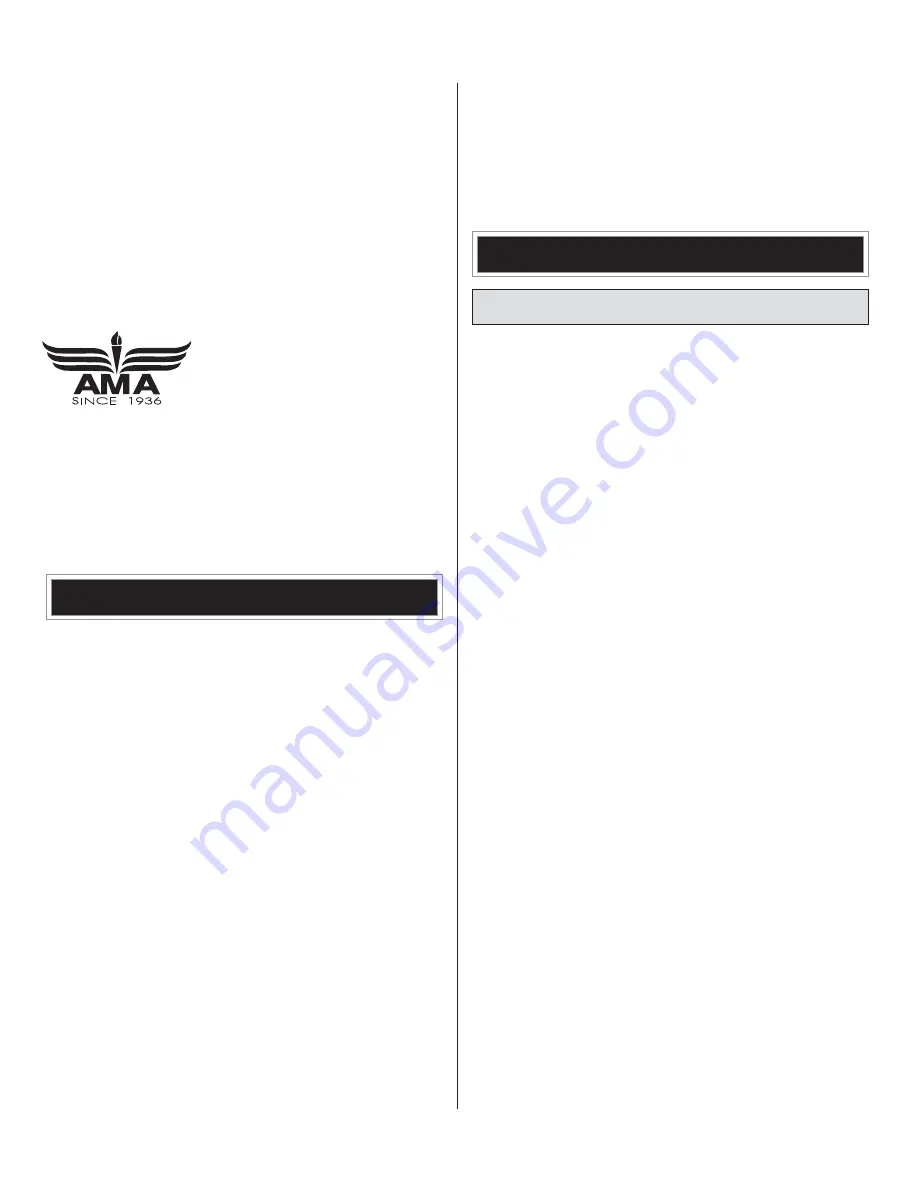
3
3
modeler. Your local hobby shop has information
about flying clubs in your area whose membership
includes qualified instructors if needed.
If you are not already a member of the AMA,
please join! The AMA is the governing body of
model aviation and membership provides liability
insurance coverage, protects modelers’ rights and
interests and is required to fly at most R/C sites.
Academy of Model Aeronautics
5151 East Memorial Drive
Muncie, IN 47302-9252
Tele. (800) 435-9262
Fax (765) 741-0057
Or via the Internet at:
http://www.modelaircraft.org
IMPORTANT!!!
Two of the most important things you can do to
preserve the radio controlled aircraft hobby are to
avoid flying near full-scale aircraft and avoid flying
near or over groups of people.
PRECAUTIONS
1. You must assemble the plane according to the
instructions. Do not alter or modify the model, as
doing so may result in an unsafe or unflyable
model. In a few cases the instructions may differ
slightly from the photos or plan. In those instances,
follow the written instructions.
2. You must take the time to build straight, true
and strong.
3. You must install all R/C and other components
so that the model operates properly on the ground
and in the air.
4. You must test the operation of the model before
the first and each successive flight to insure that all
equipment operates correctly. You must also make
certain that the model has remained structurally
sound.
Please inventory and inspect all parts carefully
before starting to build! If any parts are missing,
broken or defective or if you have any questions
about building or flying this model, please call us
at:
(217) 398-8970
or you may email us at
productsupport@dynaflite.com
and we'll be
glad to help. If you are calling for replacement
parts, please look up the part numbers and have
them ready when calling.
PREPARATIONS
REQUIRED ITEMS
These are the items not included with your kit; you
will need to purchase them separately. Items in
parentheses (GPMQ4131) are suggested part
numbers recognized by distributors and hobby
shops and are listed for your ordering convenience.
GPM
is the Great Planes
®
brand,
TOP
is the Top
Flite
®
brand and
HCA
is the Hobbico
®
brand.
❏
4+ Channel radio w/6 servos (5 high torque)
❏
2 18" Servo extension wires (ailerons)
❏
2 “Y” Connectors (ailerons, elevators)
❏
Engine: 1.20 - 1.60 4-stroke,
1.08 - 1.8 2-stroke, or 1.5 - 2.1 gas
❏
Engine mount and mounting hardware
❏
16 - 24 oz. Fuel tank
❏
Standard fuel tubing, glow (GPMQ4131)
❏
Tygon fuel tubing, gas (DUBQ0427)
❏
Gas stopper (DUBQ0675)
❏
2 3-1/4" Main wheels (GPMQ4226)
❏
1 1-1/2" Tail wheel (GPMQ4243)
❏
4 5/32" Wheel collars (GPMQ4306)
❏
2 1/8" Wheel collars (GPMQ4304)
❏
2 3/16" Axles (GPMQ4278)
❏
20 Giant Scale hinges
❏
4 8-32 x 1" Socket head bolts (GPMQ3048)
❏
4 8-32 Blind Nuts (GPMQ3328)
❏
Coverite
™
Fabric or other covering
(approximately 5 rolls)
❏
Paint for fuelproofing, engine cowl and
windows
❏
1/4" Latex Foam Rubber (HCAQ1000)
❏
3" Spinner (GPMQ4530)
❏
1 or 2 1/4 Scale pilot(s) (optional)
(DGAQ2110)
❏
Decathlon cockpit kit (optional) (DYFQ8115)




































